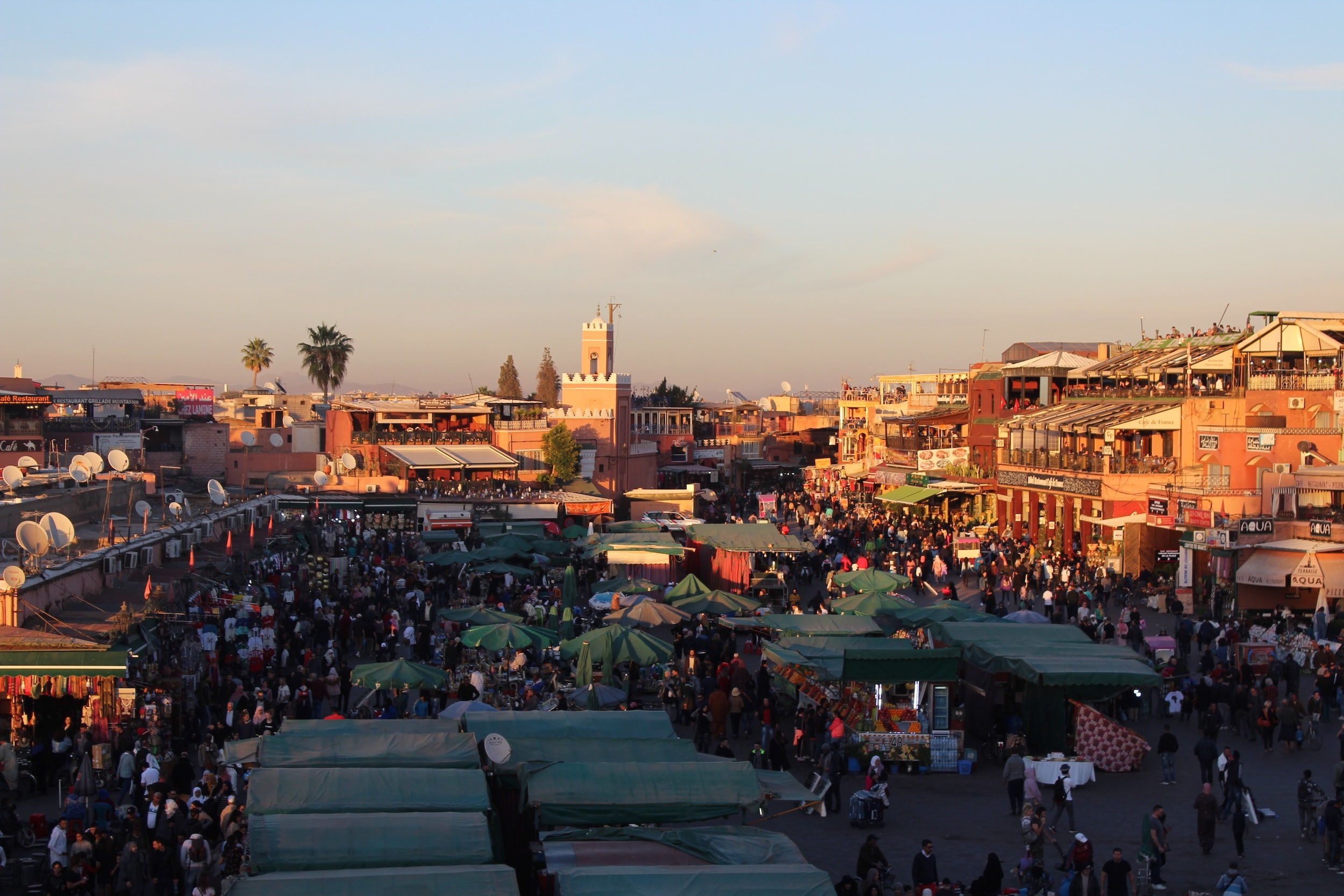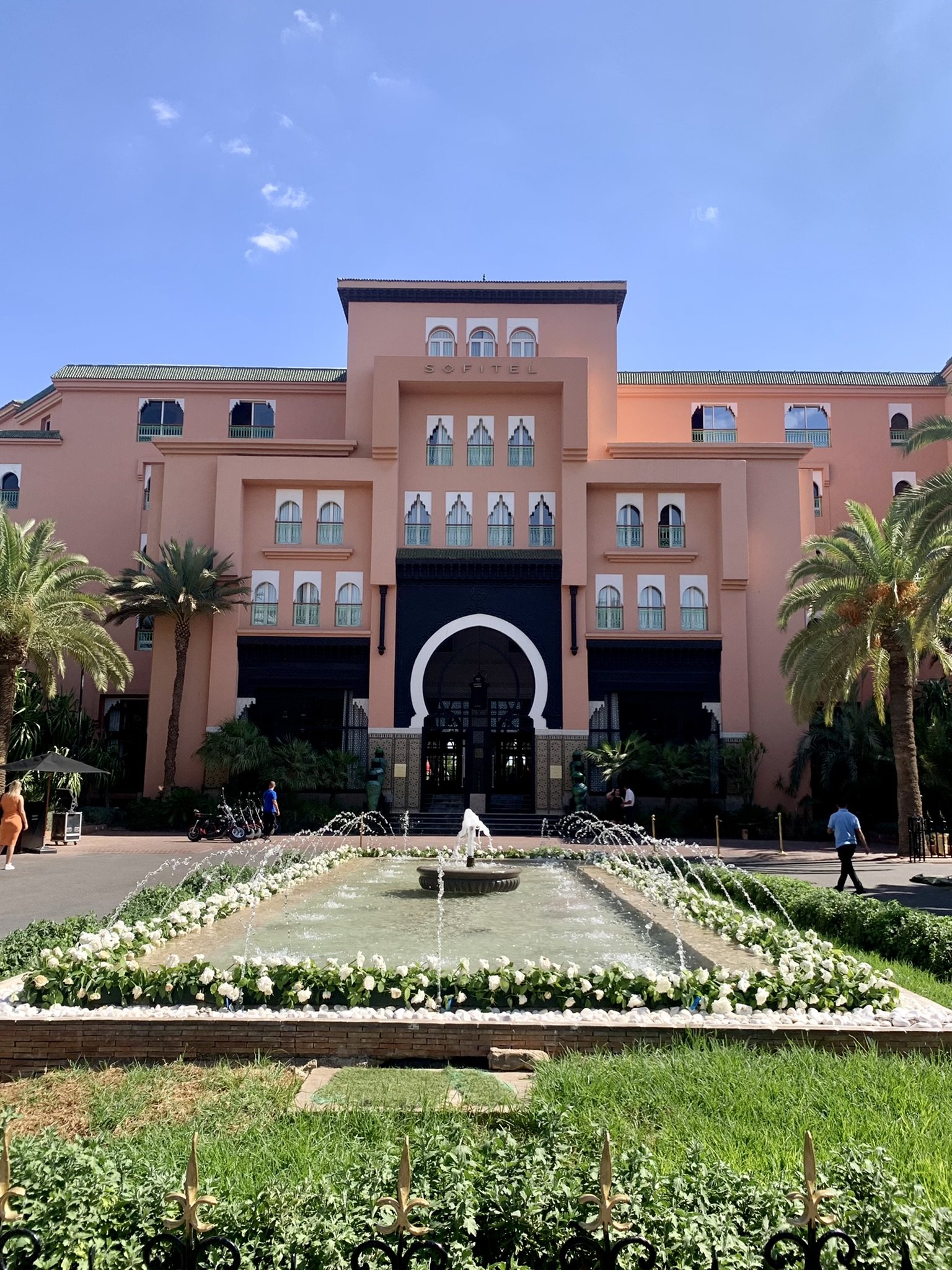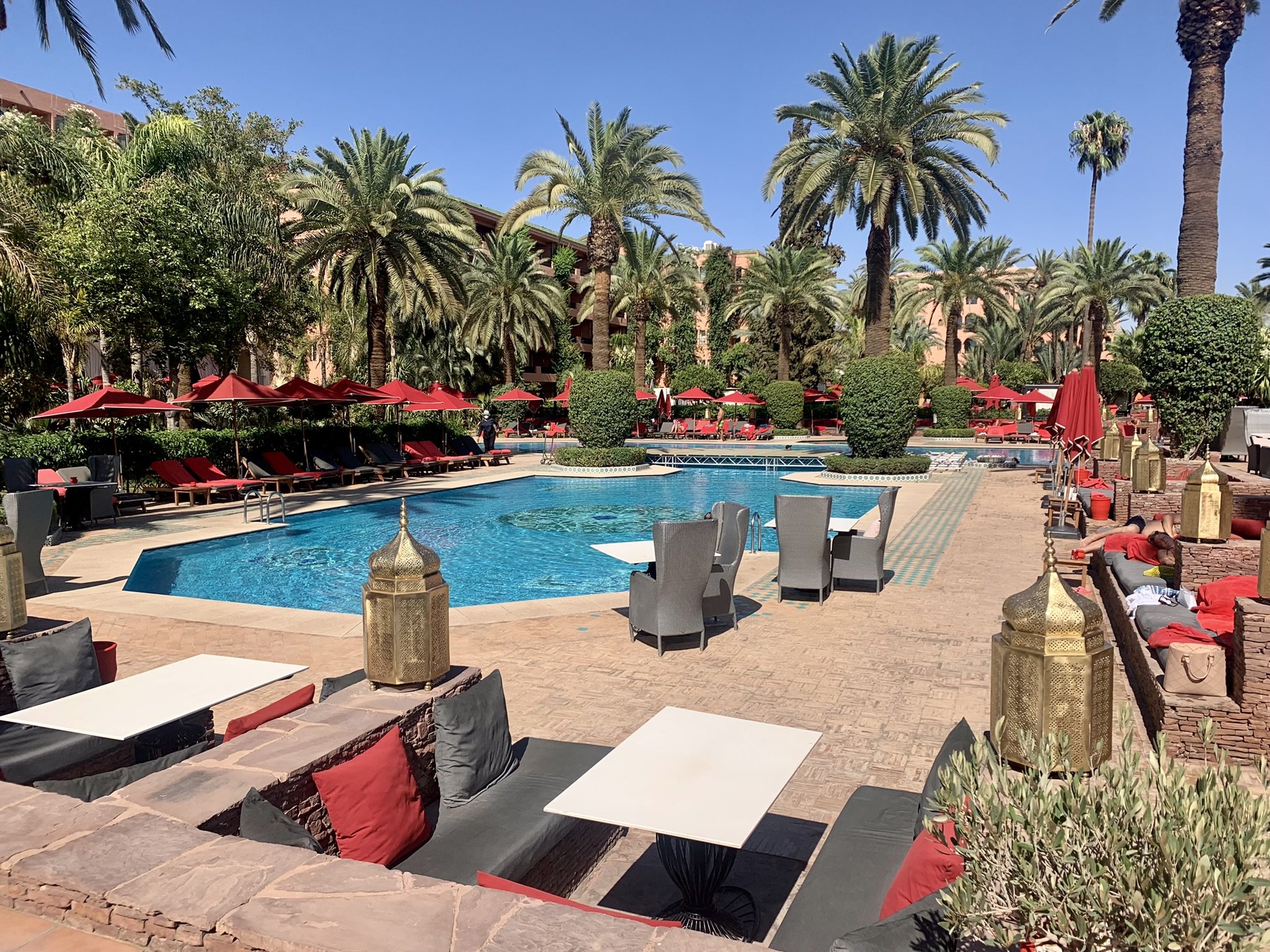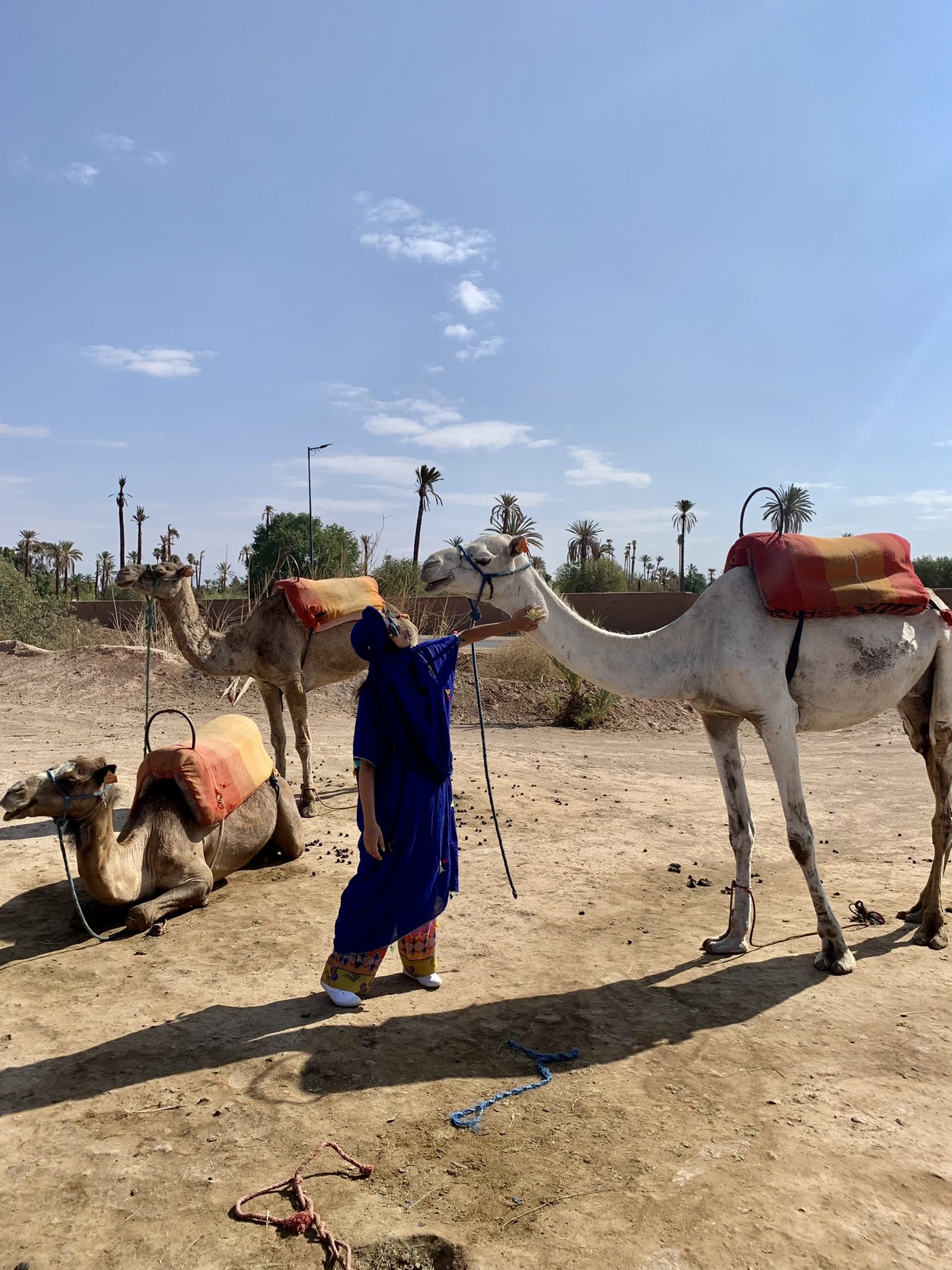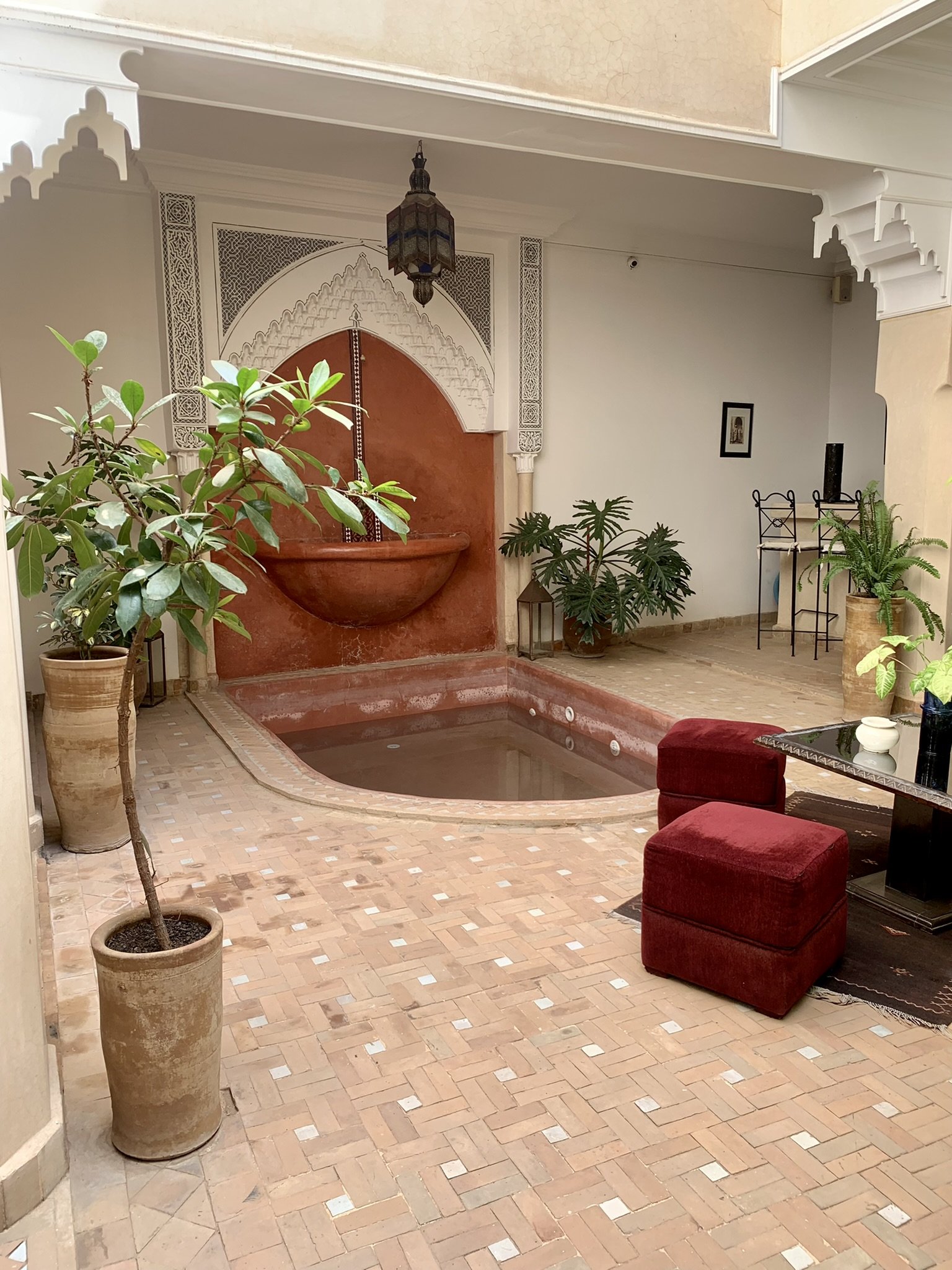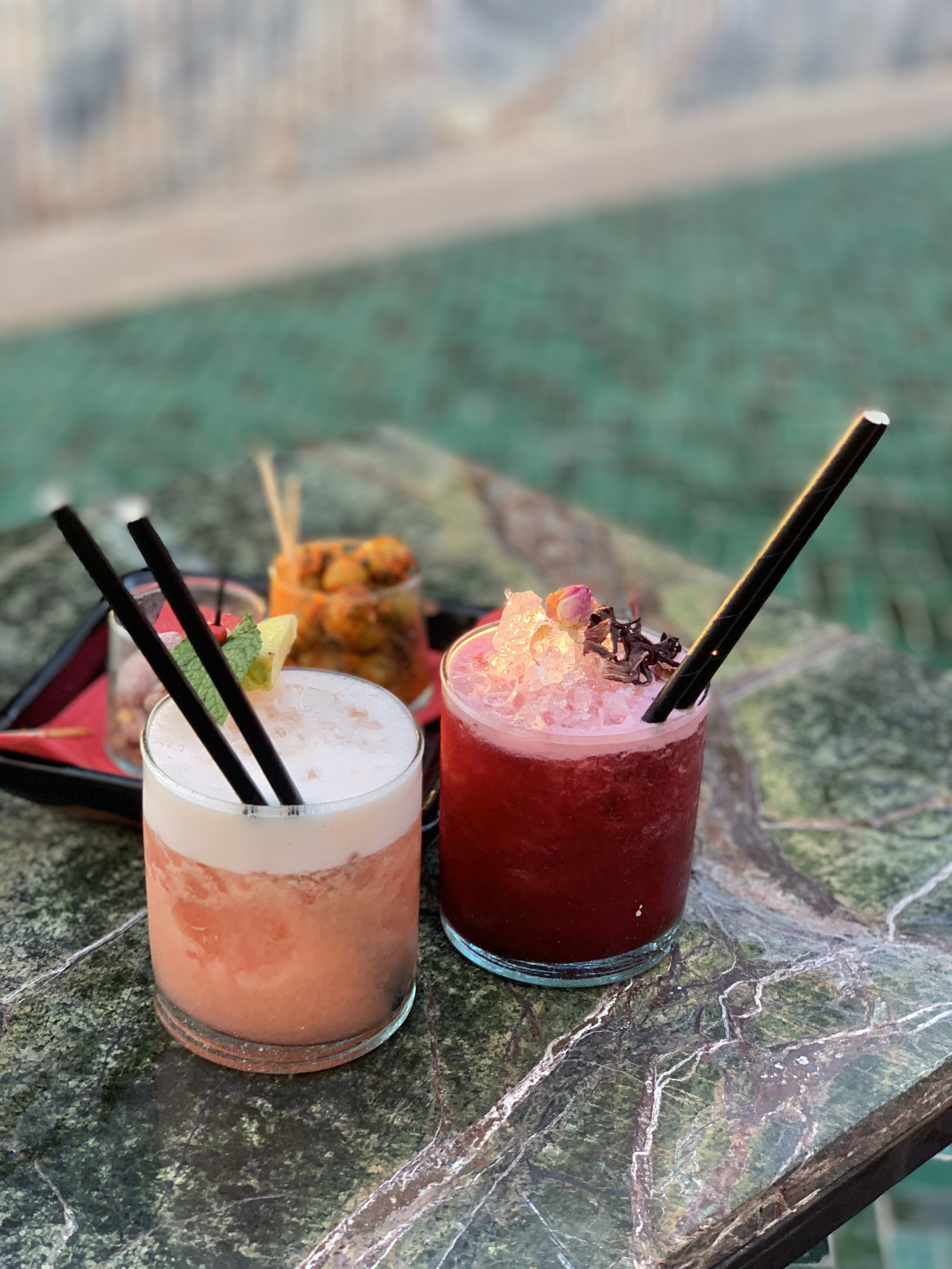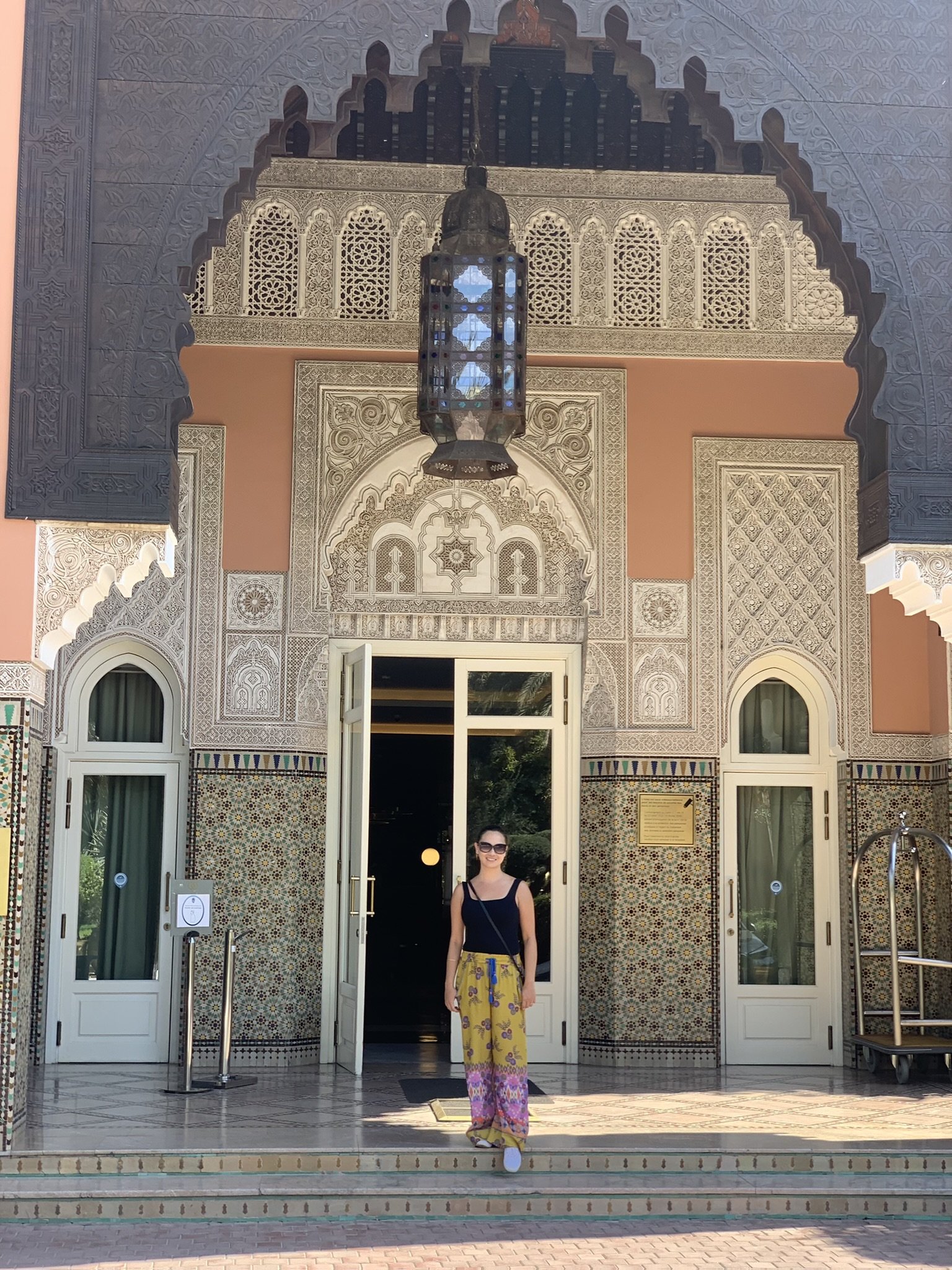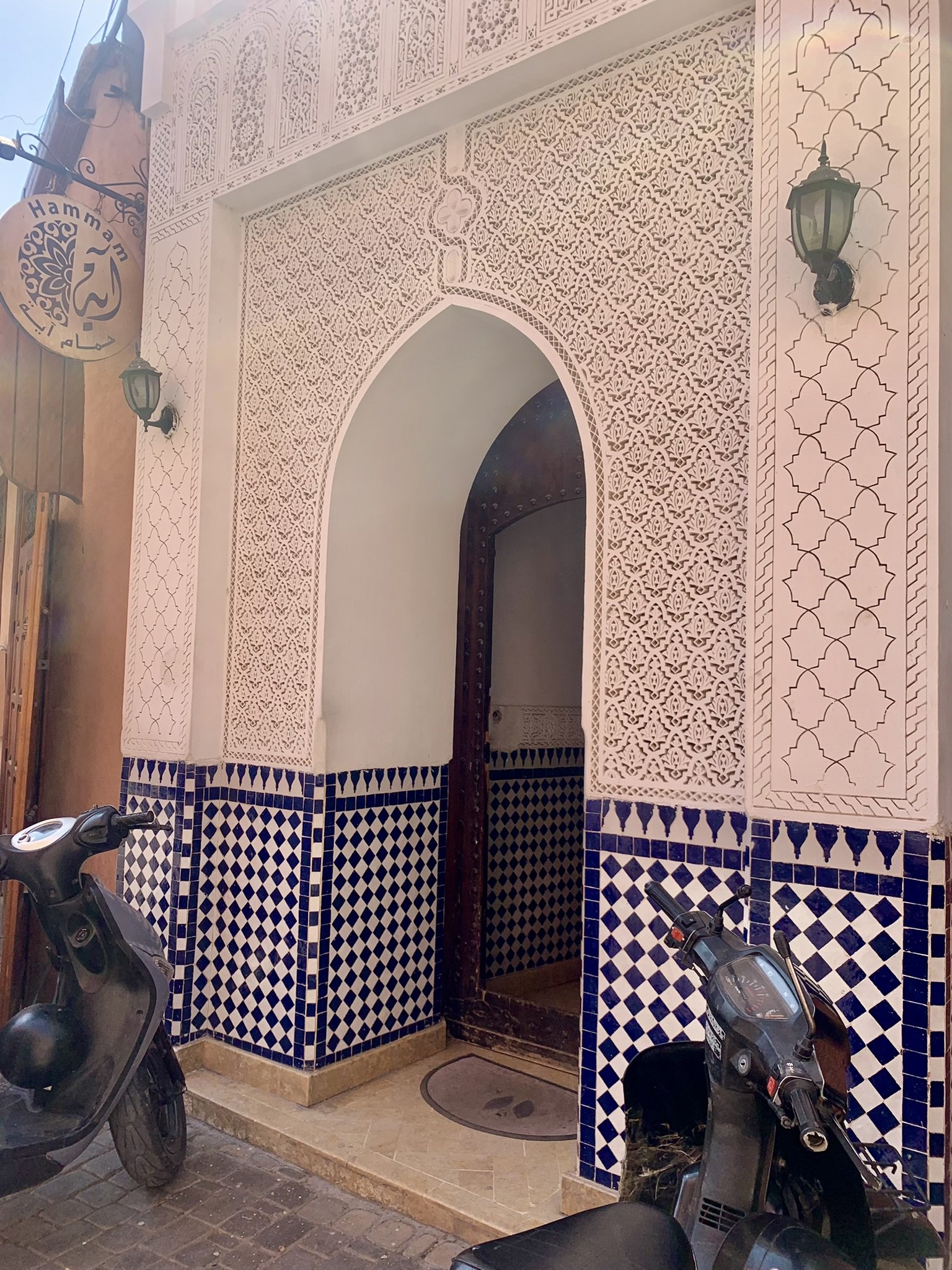
Stopover Series: Marrakech
Snapshot
Jessica visited Marrakech, Morocco with her husband on their honeymoon in September 2023 for just 3 nights.
3-4 nights are recommended.
Highlights
Visit the beautiful Majorelle Gardens, designed by Yves St Laurent
Enjoy delicious Moroccan cuisine, from street food to 5-star dining
Ride a camel through part of the Sahara desert
Learn about the medicinal use for different spices, herbs and oils at a Moroccan ‘pharmacy’
Barter for unique handmande items at the Jemaa el-Fnaa Medina (and just try not to get lost!)
Sip craft cocktails as the sun sets, and the call to prayer rings out
“Marrakech a fascinating and beautiful city, but it can be quite overwhelming. Sensory overload is not an understatement! I would recommend booking tours of the top sites with experienced local guides, as they’ll give you the best insight. It is also an amazing place to shop, but sellers can. be aggressive - don’t be afraid to haggle to get a good price.”
Day 1 - Relax by the Pool, Eat a niceDinner
We arrived by air, flying in from Malaga airport in Spain on a short 1 hour 20 minute flight. The Marrakech airport was very clean, well staffed, and was a smooth experience ; we were landed, through security, and out of the airport in 15 minutes or less! (Note: this was without having to wait for checked luggage - we like to travel light and typically do carry-on only).
We had a private transfer booked for the airport that promptly whisked us off to our hotel, located in the chic Hivernage area of Marrakech. This neighborhood is great for a first-time trip because it is safe, clean, and home to many of the fanciest hotels, restaurants, and shops. It is also not too far from Koutoubia mosque and the medina, which about a 15-25 minute walk away.
We walked around this whole area, even at night, and it felt very safe. Once, a group of kids rode by us on their bikes, and all gave us big smiles and said “bonjour!”
It is a walkable city in the sense that everything is fairly close… But, everywhere in Marrakech you’ll find that the pavement and walkways can be broken or missing, so be careful and watch your step. I’d recommend flat, comfortable shotes for walking around. The medina and many lanes are simply red dirt floors. Good news - cabs are everywhere, and getting a ride anywhere in thee city is pretty inexpensive.
We were staying at the Sofitel Marrakech Lounge & Spa, a beautiful 5* hotel with three outdoor swimming pools, restaurants, a spa, and lush tropical grounds.
I chose this particular hotel based on the design, location, and the stunning pools. It felt artistic and luxurious, but wasn’t particularly authentic.
The design of this hotel was so gorgeous, all the details and decor were on point - everywhere you looked was elegantly decorated with a style that combines contemporary Moroccan design with French elegance.
I had fallen in love at first glance of the photos online, and it didn’t disappoint in reality.
As a big pool lover, this place delivered in spades: 3 outdoor pools in total, two surrounded by palm trees, foliage, seating areas, and the most comfortable red loungers, cabanas, and day beds. I loved that you didn’t have to rent one in advance or pay extra for the day beds - just show up, and a friendly pool attendant would come by with a fresh towel and to take your drink order.
The third pool was quieter and smaller, perched above the main pool area infinity-style (pictured, below left) on the level above.
Nothing beat jumping into these gorgeous pools after a day of sightseeing in the
hot Moroccan sun!
NOTE: The Sofitel is very beautiful and luxious, but it is not the most authentic Moroccan hotel. We were looking for a bit of paampering and really liked the multiple pools that it offered, but I would also recommend staying at a riyad nearby the medina for a more authentic experience; that is what I’d like to do next time. It would be noisier at night, however - the Hivernage area is quieter.
Many riyads were fancy homes or villas that were taken over and redesigned as small boutique hotels, often with just a few rooms. But be careful when booking, many of them do not offer air conditioning - an absolute must in the dry, hot heat!
We spent the first afternoon relaxing by the pools at our resort.
For dinner, we went to the restaurant at La Maison Arabe, which is a gorgeous riyad just outside of the medina.
This was a wonderful dining experience that I highly recommend, although it was difficult to book and to find… we weren’t able to make a reservation in advance, so we just showed up early and got lucky. We arrived at around 6 or 6:30pm, and they happened to have an available table.
Once you find this hidden little spot among the winding streets of Marrakech, you are led through the pretty riyad into a small central courtyard, where tables and chairs set up under trees and around a small pool of water.
Even though you are just outside of the busy medina, it is peaceful and quiet in here.
The service is very friendly and relaxed, we enjoyed chatting with the waiter (in French), and he helped to recommend some cocktails and Moroccan dishes.
After the cocktails, we ordered a nice bottle of Moroccan wine (yes, it exists!), and received some delicious olives and roasted nuts along with it - these are common appetizer snacks in Marrakech, we found. There is also homemade bread and oils for dipping.
For dinner, I ordered slow-cooked lamb in a pear and roasted almond sauace, topped with more roasted almonds. My husband got the 7-vegetable tagine, also with lamb, on a bed of couscous. Both were absolutely amazing, just delicious food with very large portions. We basically cleaned the plates, it was so good!
As the sun sets and the restaurant starts to fill up, the restaurant is slowly lit up with little candles on the tables and fairy lights in the tree branches, making it very romantic and atmospheric.
At around 8 o’clock, two local musicians started singing and playing music on the oud, a traditional Arabic instrument with a melodic sound. We listed to the music drift up to the stars, and finished off our bottle of wine before walking back to the hotel.
Day 2 - Jardin Majorelle, Camel Riding, & Spice Shop
For our first full day in Marrakech, we headed to the famous Jardin Majorelle, a 2-acre landscaped botanical garden in the heart of the city. We actually had a day tour booked in advance, but unfortunately they cancelled on us the night before. Instead, we found a great local taxi driver right outside of our hotel that morning, who took us around for most of the day.
Our driver turned out to be great - the hero of our time in Marrakech! Sometimes you just need to go with the flow… and trust in a friendly local. He had lived in Marrakech all of his life, had no teeth (but smiled a lot), and could only speak French.
At the Jardin Majorelle we bought tickets right as it opened for the day, and then we wandered around on our on while our driver waited for us. Even right after opening, there was already a small lineup outside, and it was packed with visitors inside.
These gardens are absolutely gorgeous - a very special place, and a must see.
Created over the course of forty years, [Jardi Majorelle] is enclosed by outer walls, and consists of a labyrinth of crisscrossing alleyways on different levels and boldly-coloured buildings that blend both Art Deco and Moorish influences. The French painter Jacques Majorelle conceived of this large and luxuriant garden as a sanctuary and botanical ‘laboratory’. In 1922, he began planting it with exotic botanical specimens from the far corners of the world. In 1980, Yves Saint Laurent and Pierre Bergé[…] purchased the Jardin Majorelle to save it from destruction at the hands of hotel developers.
- from JardinMajorellle.com
As visitors walk along the pathways, each new area is full of exotic plants and trees; my favorites were the many cactuses and succulents from around the world.
It doesn’t take long to walk through all of the gardens are and visit the iconic blue house, only about an hour or so. However, we didn’t visit the Pierre Bergé Museum of Berber Arts. It looks wonderful though - we will visit it next time for sure. It requires a separate ticket.
There is also a cute little cafe and boutique here as well.
Tips for visiting:
Having a private guide to provide more information would have been nice, so that is what I would recommend. It offers a great opportunity to learn much more than you would on your own about this beautiful place.
Also, be sure to arrive early as it only gets busier and busier as the day goes on. Check opening times a few days before your visit and try to arrive right when it opens.
It is recommended to purchase tickets in advance for faster access to the park
(Note: we didn’t purchase tickets in advance, and were still fine). You can buy them online, or at the front gate entrance.
Next, our driver took us out into what felt like the middle of nowhere, but was actually fairly close to the central city.
Riding camels wasn’t something I was particularly dying to do, thinking that they may be mistreated or something. But, when we got there and saw the camels, they looked so happy, lazy, and well taken care of, munching on some straw in the shade as we drove up. We just had to try it!
The camel’s handler dressed us up in the traditional cobalt blue robe and headpiece, we got on the camels, and off we went.
The handler led us around a Moroccan corner of the massive Sahara desert for about 20 minutes or so, among the palm trees and sad dunes, with not much else around. It was quiet, relaxing, different, and overall really fun!
Camels are not as uncomfortable as we expected, although I think a short ride - 30 minutes or so maximum - is key to that. They are also very cute, sweet animals who like neck pets.
Our final stop that day was just outside of the Medina, which we wanted to try wandering on our own.
The driver took us to a local spice shop, which was like a Moroccan pharmacy, full of herbs, spices, and other natural medicinal remedies for every kind of health problem big or small.
The man who worked at the shop was so incredibly knowledgeable about the products (pictured right). He took us around the whole shop, explaining about the different items and their specific medical benefits. It was amazing how so many issues or ailments had a herb, spice, tonic or oil to aid it - a very different approach to Western medicine. They’ve been using these remedies for centuries here in Morocco, so something must be working.
Everything in the shop was natural, and many things were made in-shop by hand with their ancient-looking presses and machines. I picked up some fantastic Argan oil, herbal tea, spice blends, a white rock of natural deodorant, and a few other items - all for a very low price. This shop also smelled amazing, it was jam-packed with wonderfully scented products.
I wish I knew the name of this spot… sorry! But there are many similar shops in and around the medina. Visiting one is a must-do, for the learning and sensory experience alone.
Day 3 - Food & Shopping in the Medina
The next day had a much more relaxed start.
We had a private food tour of the Medina (old city) booked for lunch time, so we headed over there to meet up with our local guide, El Hassan. We booked him through a great company that connects visitors like us with local experts, called WithLocals - the tour wee did with him was the 10 Tastings of Marrakech (info here). I would highly recommend him, and this tour. It was very authentic experience of all things food in Marrakech, since Youssef had lived in Morocco his whole life and had been doing such tours for years. He took us to so many interesting places that we never would have gone to on our own.
We met El Hassan in the main square of the medina, and then set off on foot on our foodie adventure.
First we went to a ‘super local’ (in his words) little food stall somewhere in the medina, to sample the ‘fast food’ of Marrakech.
We tried a popular local dish of little meatballs, egg, and tomatoes fried in a pan and served with fresh bread to use as a utensil (pictured left) - delicious, and so simple! I’m not sure what it was called, but it is a very good dish.
We also tried a smoothie/milkshake made with fresh avocado and orange, also a local favourite (I wasn’t a huge fan, but the husband loved it).
I preferred the pomegranate juice that you can find at stalls all around, fresh-squeezed from fat reed pomegranates right in front of you.
Next, El Hassan took us to the famous Jemaa el-Fnaa square , also known as ‘Death Square’ (pictured right).
This UNESCO World Heritage Site next to the medina is pretty open and sparse during most of the day, with just a few small stalls of people selling things (mostly food), and men with snakes and moneys on chains waiting for tourists… it is pretty sad to see these poor monkeys on leashes and in cages. Side note - please DO NOT take photos or interact with them!
Every single night, this square transforms into the most epic food market/night party ever. More on that later.
El Hassan brought us to a wonderful sweet-smelling bakery, where we got to try a bunch of delectable bite-size desserts. Many of them had a combo of honey, phyllo pastry, and nuts in them; some had chocolate and other sauces involved. These treats are popular local snacks or after-meal desserts.
Then we went for some traditional vegetable salads (pictured below) at another local restaurant in the medina - they were just okay, but the real treat was talking to El Hassan.
We learned a lot about the Muslim religion that we didn’t know, and also what a typical Moroccan family’s life is like. For example, right now it is very difficult to find work in Morocco, so many of the young people are moving abroad to North America or Europe.
It is a wonderful country, but not without problems. Tourism is growing, but it is very concentrated in the main cities and sites. El Hassan hopes that eventually, more people will also want to see the more remote but unique places, like Dhakla.
We kept going deeper and deeper into the medina with El Hassan, eventually to where there were more locals and way less tourists (and much less aggressive sellers too). He took us through so many winding crazy streets and narrow alleyways, it would be impossible to find our way without him.
The stalls were selling mostly home goods in this area, like beautiful woven carpets, pottery, baskets, pillows, poufs, furniture, and decor items. The selection was endless and amazing.
I wanted to buy it all!!
Many items are hand-made by the locals, but some things are fakes. A good guide can help you distinguish which is which. El Hassan also offers shopping tours of the medina, where he helps visitors find the best, must authentic items and also helps them barter with the local sellers for a good price. He has relationships with many of the sellers, since he is in the medina so often. Almost everything can be shipped to you from Morocco.
The medina is an absolutely amazing place to buy unique items, especially for the home. I’m planning a trip to go back with my mom, and plan to do some serious shopping for my condo.
Items you buy here aren’t cookie-cutter - you know you’re getting something special and different. You can also find some amazing deals and low prices, compared to what wee are used to back home in North America.
There are other sections of the medina that sell tons of other items such as clothing, bags, shoes, jewelry, spices, instruments, food, and basically anything you can think of.
After some shopping, El Hassan gave us a break from hustle and bustle of the busy medina as we retreated into a peaceful riyad. Here, we enjoyed some mint tea and seafood pastilla (pictured below), which is another popular Moroccan dish; it is a crispy phyllo pastry with chopped up seafood and vermicelli noodles inside. I loved this, it was probably my favourite dish of the tour.
El Hassan wanted to also take us to try tagine, but we were both pretty stuffed at that point (and had already tried it the night before - it’s wonderful, but a lot of food).
So, he took us back to the square that we started in, and we said goodbye.
The medina is just fascinating, but overwhelming, and unlike anywhere else I’ve ever been. It is quite a sensory overload, and without a guide we would have definitely been lost and disoriented.
Having a local guide like El Hassan is a must for the medina.
For our final dinner in Marrakech - and to wrap up the foodie day from heaven - I had booked us a table at El Fenn, one of the top-recommended restaurants in the city. It has stunning design and great views from its rooftop position above a funky boutique hotel, and is also known to have great food & cocktails.
We enjoyed some delicous, pretty cocktails on the open-air patio as the sun set, streaking gorgeous cxolours across the sky above the rooftops.
For dinner at El Fenn, we had seared scallops, spinach salad, and beautifully cooked fish. It was wonderful, but not authentic Moroccan at all.
NOTE: I had to book this restaurant a few weeks in advance, be warned - it gets booked up very early.
A word on Moroccan design:
It is just STUNNING.
The Islamic-style tile work, the red clay, the colours, the doors, the archways, the attention to small details, it is really quite special. If you’re a lover of beautiful spaces and design, you’ll love this city.
There are many examples of beautiful design, both large (like hotels, fancy restaurants, mosques) and small (like so many doorways) hidden all throughout the city.
Here are just a few examples that I encountered.
Tips to Prep for Morocco
For me, Morocco was a huge culture shock compared to life in North America, but I absolutely fell in love with it and cannot wait to go back! With a bit of advance knowledge and preparation, it is not a scary or unwelcoming place at all - quite the contrary, actually. People are friendly and kind, but Marrakech is full of constant life, activity, people, cars, scooters, donkeys, moving in all directions, all the time. It can be overwhelming.
Here are a few key insights to help:
Women should dress conservatively
You don’t need to go overboard or wear a hijab (actually, please don’t if you are not Muslim), but keep the revealing outfits and miniskirts for another trip. I would recommend loose, light & breathable clothing; pants or dresses that that go past your knees, and tops that cover your shoulders and are not low-cut. If in doubt, I always brought a light cardigan that I could throw on over top. But, no need to shy away from colour or patterns!
For shoes, definitely go with comfort over cuteness - the streets are very uneven, with broken sidewalks and unpaved areas, so you need to be able to walk around comfortably and safely. I didn’t wear heels at all the entire time in Morocco.
Everyone speaks French
French has a long history of being spoken in Morocco, and you’ll find that everyone here speaks both French and Arabic. English beyond a few basic words/phrases is not widely spoken, but it is more common among those who work in the hotels, taxi’s, and restaurants.
If you do know a few words in Arabic, even better! Local people are always warmer to those who make an effort to learn their language and culture.
Bring local cash
Make sure to bring enough currency for you to shop, eat, and whatnot without having to take out money locally. I made the mistake of only taking out a bit of Moroccan dirham before arriving, and we ran out pretty quick. Restaurants and established shops will usually accept credit cards, but many places only accept cash - especially in the medina, where you can find the best shopping.
We did find several vendors in the medina that would accept Visa, but unfortunately my Canadian Visa card would not work at all! I have travelled all over, and Marrakech was the first place that I’ve ever had this issue... We tried to find an ATM, but they were few and far between - we ended up using the one at our hotel, but the fees were high.
Plan ahead, and bring a good amount of cash. You can always convert it back afterwards, but you won’t want to be short for shopping in the medina.


